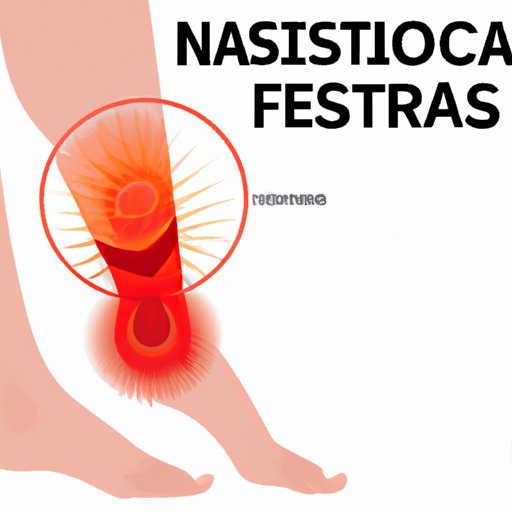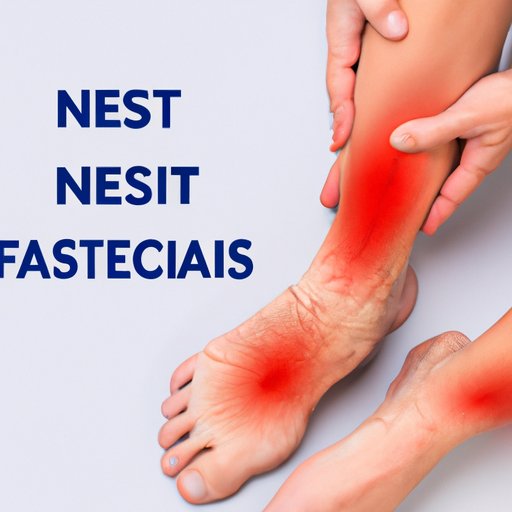
Introduction
Necrotizing Fasciitis, commonly known as flesh-eating disease, is a rare but serious bacterial infection that affects the body’s soft tissue. It can cause severe damage to the skin, muscles, and underlying tissue and may lead to life-threatening complications if not treated in time. To protect oneself, it’s essential to understand its symptoms. In this article, we will discuss Necrotizing Fasciitis symptoms, red flags, early detection, and preventive measures.
Understanding the Symptoms of Necrotizing Fasciitis: A Comprehensive Guide
Necrotizing Fasciitis is a rapidly progressing disease that destroys tissues as it spreads. It can begin with a minor scratch or cut and may not be noticeable until it has taken hold in the body. The symptoms of Necrotizing Fasciitis can be quite subtle in the early stages. They can often mimic those of a common flu-like illness, which makes it challenging to diagnose.
The disease can be categorized into two forms – type I and type II – depending on the bacteria that caused it. Type I is common and usually associated with group A Streptococcus infection, while type II is associated with other types of bacteria, such as Clostridium and Vibrio vulnificus.
Overview of symptoms
The general symptoms of Necrotizing Fasciitis include:
- Severe pain or discomfort in the affected area
- Fever
- Chills
- Nausea
- Vomiting
- Weakness
- Redness, swelling, and tenderness around the infected area
In-depth discussion of each symptom
Severe pain or discomfort in the affected area
Severe pain or discomfort in the affected area is one of the most common symptoms of Necrotizing Fasciitis. It often starts as a throbbing pain, which gradually increases in intensity and spreads. The area around the wound may remain tender, and touching it may become unbearable. If you experience such pain with a wound, it’s essential to seek medical attention immediately.
Fever
Fever is another symptom of Necrotizing Fasciitis that often accompanies pain in the affected area. The fever can be mild or high-grade and may come and go. In some cases, fever may be the only symptom of the infection.
Chills
Chills are a common symptom of Necrotizing Fasciitis, and they usually accompany fever. The chills may be intermittent or continuous, and you may experience other flu-like symptoms such as body aches and shivering.
Nausea and vomiting
Some people may experience nausea and vomiting along with other symptoms of Necrotizing Fasciitis. These symptoms can be due to the body’s response to bacterial toxins, which can cause damage to internal organs.
Weakness
Weakness is a common symptom of Necrotizing Fasciitis, and it can affect your ability to perform daily tasks. You may feel fatigued and have trouble staying awake due to the illness’s effect on your nervous system.
Redness, swelling, and tenderness around the infected area
Redness, swelling, and tenderness around the infected wound are the most evident symptoms of Necrotizing Fasciitis. The area around the infected wound may appear red, swollen, and hot to the touch. It is essential to be aware of these symptoms since they may be the first indication of a severe bacterial infection.
Recognizing Necrotizing Fasciitis Symptoms: Red Flags to Look Out For
Necrotizing Fasciitis can progress very quickly, and early detection is crucial. Knowing the red flags of the disease can save lives. If you have an open wound or have been in contact with someone who has Necrotizing Fasciitis, keep an eye on the following symptoms:
- Fever with a wound or sore area on your skin
- Rapidly changing redness or discoloration on the skin
- Swelling and warmth of the skin in the affected area
- Severe pain, including beyond the site of the wound
- Foul-smelling fluid oozing from the wound
Importance of Early Detection: Symptoms of Necrotizing Fasciitis
Early detection is crucial when it comes to Necrotizing Fasciitis. The disease can progress from minor symptoms to life-threatening complications in as little as 24 hours. Early detection can increase the chances of successfully treating Necrotizing Fasciitis.
Explanation of why early detection is crucial
Early detection of Necrotizing Fasciitis is crucial because the disease can rapidly spread throughout the body. In some cases, it can cause sepsis, a life-threatening condition that occurs when bacteria enter the bloodstream and spread throughout the body. Sepsis can cause organ failure, shock, and even death. Early detection can prevent this from happening.
In-depth discussion of each symptom
Fever with a wound or sore area on your skin
The presence of fever along with a wound or sore area on the skin can be an indication of an infection. If you experience a fever of 100.4F or higher and have an open wound or sore area, it’s essential to seek medical attention immediately.
Rapidly changing redness or discoloration on the skin
If you notice any rapidly changing redness or discoloration on your skin, it could be a sign of Necrotizing Fasciitis. The skin around the wound may appear red, and the redness may spread quickly throughout the body.
Swelling and warmth of the skin in the affected area
Swelling and warmth of the skin in the affected area are common symptoms of Necrotizing Fasciitis. The skin around the wound may appear puffy, and it may feel hot to the touch.
Severe pain, including beyond the site of the wound
Severe pain, including beyond the site of the wound, is another symptom of Necrotizing Fasciitis. The pain may spread rapidly throughout the body and can be quite intense.
Foul-smelling fluid oozing from the wound
Foul-smelling fluid oozing from the wound is an indication of Necrotizing Fasciitis. The fluid may be dark and resemble pus, and it may have a foul odor due to the bacteria’s presence.
When to See a Doctor: Signs and Symptoms of Necrotizing Fasciitis
If you observe any of the symptoms mentioned above or suspect that you or someone you know may have Necrotizing Fasciitis, it’s important to seek medical attention immediately. Waiting even a few hours can increase the risk of complications and, in severe cases, can be fatal.
Explanation of when to seek medical attention
If you suspect that you or someone you know may have Necrotizing Fasciitis, it’s essential to seek medical attention immediately. The symptoms can progress quickly and have severe consequences. Don’t wait to see if the condition improves on its own.
In-depth discussion of each sign
Swelling and redness that spreads quickly
Swelling and redness that spreads quickly may be an indication of Necrotizing Fasciitis. This symptom can be quite noticeable and can spread to other parts of the body.
Fever and chills
Fever and chills often accompany Necrotizing Fasciitis. If you have a fever of 100.4F or higher, it’s essential to seek medical attention.
Severe pain in the affected area
Severe pain is another sign of Necrotizing Fasciitis. The pain may be throbbing, and touching the affected area may be unbearable.

Necrotizing Fasciitis Symptoms: What You Need to Know to Protect Yourself
The best way to protect yourself from Necrotizing Fasciitis is to know the symptoms and take preventive measures.
Prevention techniques
Preventive techniques include keeping your skin clean and healthy, practicing good wound care, avoiding contact with contaminated objects or soil, and wearing protective clothing. If you have open wounds, it’s essential to keep them clean and covered.
Explanation of how to protect yourself
The best way to protect yourself from Necrotizing Fasciitis is to maintain good hygiene and practice proper wound care. If you have an open wound, keep it clean and covered. Avoid contact with contaminated objects and soil, and wear protective clothing when necessary.
Discuss the importance of good hygiene and wound care
Good hygiene and wound care are essential when it comes to preventing Necrotizing Fasciitis. Keeping your skin clean and healthy can reduce the risk of bacterial infections. If you have an open wound, it’s important to keep it clean and covered to prevent the bacteria’s entry.
The Devastating Impact of Necrotizing Fasciitis: Understanding the Symptoms and Seeking Treatment
Necrotizing Fasciitis can have a devastating impact on one’s body, and it’s important to understand the symptoms and seek treatment as soon as possible.
Discussion of the potential severity of Necrotizing Fasciitis
Necrotizing Fasciitis can cause severe damage to the body and lead to life-threatening complications. If left untreated, it can spread to other parts of the body, leading to sepsis, organ failure, and even death.
Explanation of why seeking medical help early on is important
Seeking medical help early on is essential when it comes to Necrotizing Fasciitis. Prompt treatment can prevent the disease from progressing and reduce the risk of severe complications.
Overview of treatment options
The treatment of Necrotizing Fasciitis often includes antibiotics and surgery to remove the infected tissue. Depending on the severity of the infection, hospitalization may be necessary.
Conclusion
In conclusion, Necrotizing Fasciitis is a rare but serious bacterial infection that can cause severe damage to the body, leading to life-threatening complications. Early detection is crucial in preventing the disease from progressing, and recognizing the symptoms is the first step to getting prompt medical attention. By practicing good hygiene and wound care, we can reduce the risk of bacterial infections, including Necrotizing Fasciitis.





